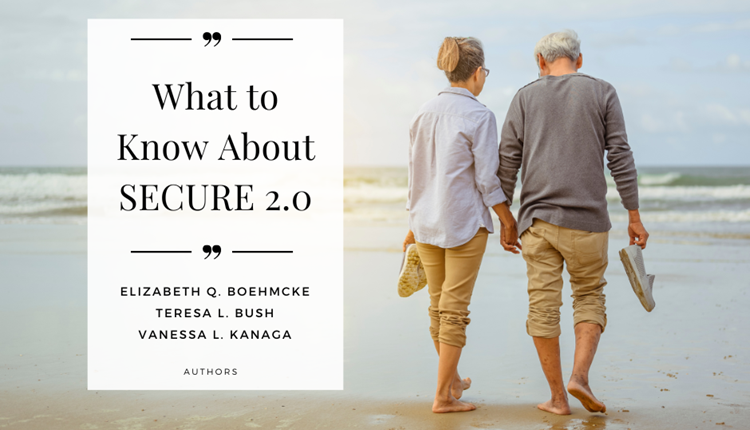What to know about SECURE 2.0
by
On February 7, 2023The Setting Every Community Up for Retirement Enhancement Act (“SECURE”), which became effective in January of 2020, made major changes in how beneficiaries of retirement plans and IRAs receive those assets after an account owner’s death.
Proposed regulations were issued last year to provide additional guidance on SECURE, but they are not yet final. However, for some time we have heard about the possibility of “SECURE 2.0,” which was – perhaps unexpectedly – included in the Consolidated Appropriations Act of 2023, passed in late December.
This sent most estate planners on a year-end quest to determine what changed (again) in the world of estate planning for retirement assets. Fortunately, SECURE 2.0 does not have the same sweeping impact as original SECURE, and most of the changes should have minimal effect on estate planning documents themselves (with one exception, which was added to InterActive Legal documents in January). Most SECURE 2.0 provisions add new flexibility for account owners and beneficiaries, and are discussed briefly in the review, below.
New Ages for Required Minimum Distributions
SECURE 2.0 changed the age that withdrawals must begin from retirement plans. For individuals born between 1951 and 1959, the age increased from 72 to 73, and for individuals born after 1959, the age increased from 72 to 75. For many clients, this means an additional three years of income tax deferral before they must start taking required minimum distributions (RMDs).
529 Plans
SECURE 2.0 added a helpful option for unused 529 plan money. Plans under Section 529 of the Internal Revenue code are a tax-efficient way to provide for the education of a specific beneficiary. In the past, unused funds had to either be redirected to a 529 plan for a different beneficiary for the same educational purpose, or distributed to the original beneficiary, subject to taxes and penalties.
Beginning in 2024, unused funds in a 529 plan can be transferred to a Roth IRA (via a direct trustee-to-trustee transfer) in the name of the original 529 plan beneficiary, with certain restrictions. The plan itself must have been in existence for at least 15 years to qualify for the Roth IRA option, and the annual limit is the taxpayer’s regular IRA contribution limit for the year reduced by other IRA contributions that year. Additionally, there is a lifetime maximum of $35,000 per beneficiary.
ABLE Accounts
In order to be an eligible beneficiary of a qualified ABLE account under current law, individuals must have onset of their disability by age 26. Under SECURE 2.0, beginning in 2026, onset of such disability must be before age 46.
New Option for Surviving Spouses
In addition to the pre-SECURE options of rolling the decedent spouse’s IRA into their own IRA, electing to treat the decedent spouse’s IRA as their own, and remaining an “eligible designated beneficiary” of the IRA, starting in 2024, surviving spouses can elect to be treated as the deceased spouse. This allows RMDs to be delayed until the deceased spouse would have reached the age for mandatory distributions (73 or 75), which can be valuable if the deceased spouse is younger than the survivor. Additionally, if the surviving spouse dies before RMDs begin, the survivor’s beneficiaries will be treated as if they are beneficiaries of the deceased spouse, which can allow them to stretch distributions over lifetime if they are eligible designated beneficiaries (instead of the 10-year term that would apply in most cases after the survivor’s death).
Charitable Planning
SECURE 2.0 makes two beneficial changes for charitably motivated taxpayers. First, Type-2 Applicable Multi-Beneficiary Trusts, which are accumulation trusts for chronically ill or disabled beneficiaries, can now have certain charities as remaindermen without adverse consequences. If a charity described in Section 408(d)(8)(B)(i) (referred to here as a “Qualifying Charitable Organization”) is named as a remainderman, SECURE 2.0 provides that the charity will be considered a designated beneficiary. What this means is that a trust can pay out to public charities (other than donor advised funds) without disqualifying the trust’s ability to take RMDs over the beneficiary’s lifetime. This change enhances the planning opportunities for clients creating supplemental needs trusts who also wish to benefit charity. InterActive Legal added language about distributions to Qualifying Charitable Organizations to our accumulation trust provisions in January.
Additionally, Qualified Charitable Distributions (QCDs) can now be made to charitable split interest trusts as part of the annual RMD. Those over age 70½ can elect to make a one-time gift, with a limit of $50,000 (which will be inflation-adjusted), to a charitable remainder unitrust, a charitable remainder annuity trust, or a charitable gift annuity, and this amount counts toward the annual RMD.
QLACs
Qualified longevity annuity contracts (QLACs) are expanded under SECURE 2.0. QLACs are deferred income annuities purchased with retirement funds typically held in an IRA or 401(k), where annuity payments begin on or before age 85 – allowing more income tax deferral beyond the RMD age. SECURE 2.0 increases the limit on how much can be placed in a QLAC to $200,000 and removes the previous requirement that limited a QLAC to 25% of an individual’s retirement account balance. For more on QLACs, see “SECURE 2.0 Opens Door for Qualified Longevity Annuity Contracts (“QLAC”), by Stephen J. Silverberg, Esq., CELA, Fellow, Cap, AEP® published on Jan 5, 2023.
Conclusion
The above information highlights what we have found to be the main points in SECURE 2.0. We encourage subscribers to post questions for discussion in our estate planning discussion forum, and we will continue to monitor the status of the proposed regulations and our planned changes to the program once they become final.
Authors

Elizabeth (“Beth”) Boehmcke joined InterActive Legal in 2018 and served as Director of Content Development until she retired in 2025.
Shegraduated cum laude from the University of Michigan Law School in 1993. After graduation from law school through 2003, she specialized in high net worth estate planning, with an emphasis on cross-border and asset protection planning, and the representation of fiduciaries managing complex trusts and family businesses.
During her career in New York, she was an associate attorney at both Rogers & Wells (now Clifford Chance) and Hodgson Russ in New York City. After a hiatus in her legal career to care for her children, she resumed her legal career by passing the Virginia bar in 2014 and began working for the Hook Law Center, P.C., where she expanded her estate planning practice to include elder law, specifically focusing on asset protection planning for Medicaid and Veteran’s benefits.
She is a proud graduate of the University of Virginia where she received a B.A. with distinction in Psychology in 1988 and is also a graduate of SUNY-Buffalo where she received an M.A. in Clinical Psychology in 1990.

Teresa Bush joined InterActive Legal in 2007 and serves as Director of Education and Support Services.
Ms. Bush has been licensed to practice law since 1991, and focused her practice exclusively on issues of estate and gift tax planning, probate, charitable planning, and estate and trust administration. She began her practice in a small law firm, planning for clients of all levels of wealth. Thereafter, she practiced for a number of years in the Tax Section of Kelly, Hart and Hallman, P.C. in Fort Worth, Texas, and as an estate and gift tax consultant for the Dallas office of Ernst & Young, in both cases focusing on planning for very high net worth clients.
Ms. Bush received her J.D. from the University of Texas School of Law, where she was a research assistant for Professor Stanley M. Johanson. She studied at Edinburgh University and the London School of Economics prior to obtaining a B.A. in Economics and Political Science from Rice University in Houston. While studying abroad, she worked as an intern for a Member of Parliament in the British House of Commons.
Ms. Bush taught legal research and writing as a Teaching Quizmaster in law school, and later taught estate planning extension courses for American College of Financial Services CLU candidates. She has presented several online webinars on estate planning and drafting topics, and is the author or co-author of a variety of estate planning articles.

Vanessa Kanaga currently serves as InterActive Legal’s Special Advisor on Estate Planning and Legal Strategy. She is the former CEO of InterActive Legal. Vanessa received her J.D. from Cornell Law School and holds a B.A. in Philosophy from Wichita State University, as well as an Advanced Professional Certificate from New York University School of Law. She is licensed in New York, Kansas, and Arizona, and currently lives in Arizona.
Prior to joining InterActive Legal in 2013, Vanessa practiced in New York, at Milbank LLP and Moses & Singer LLP, and in Kansas, at Hinkle Law Firm, LLC. She has experience in a range of estate planning matters, including high net worth tax planning and asset protection planning.
In 2024, Vanessa returned to the practice of law. She is Of Counsel at Becker and House, PLLC in Scottsdale, Arizona.


